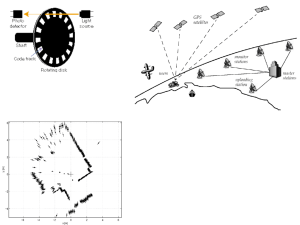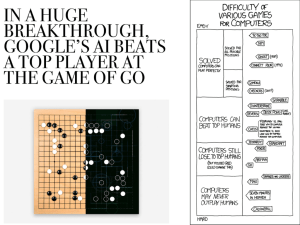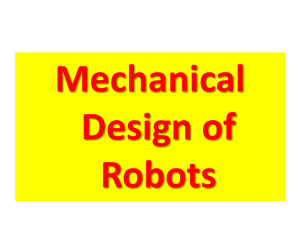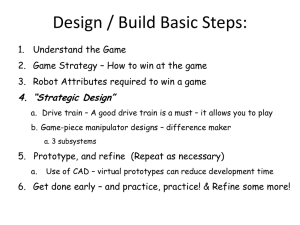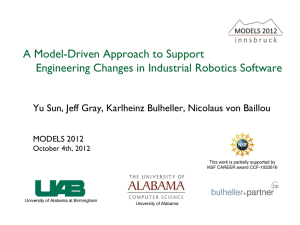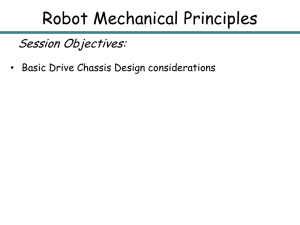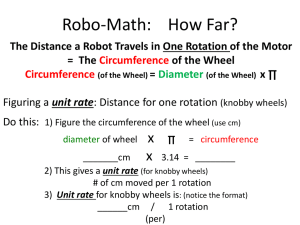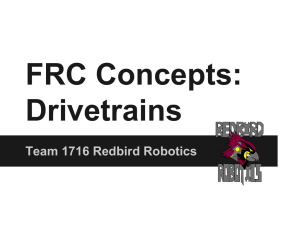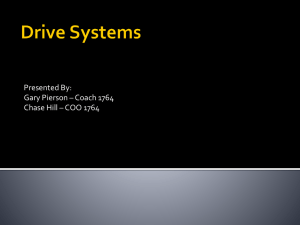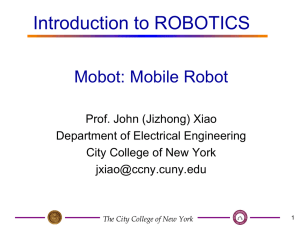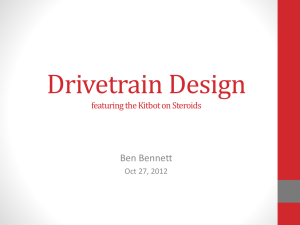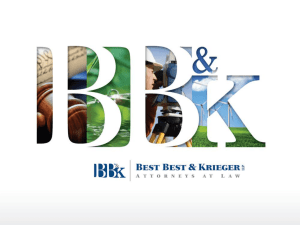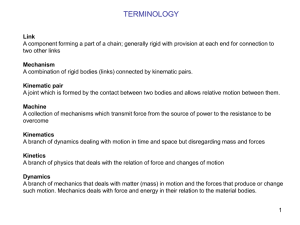Legged Control, Kinematics
advertisement
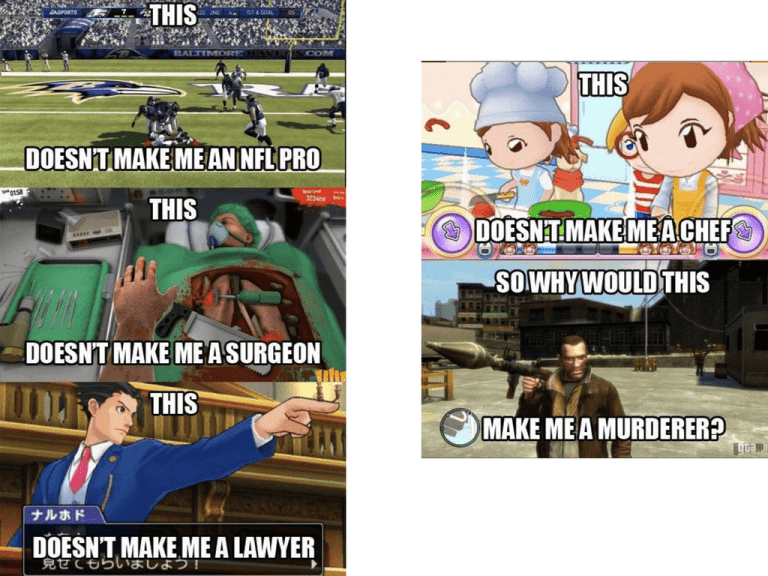
Communication • Piazza – Code • Email: Angel • Computers in Lab • Joined late – Be sure to email me to remind me! • Lab 2: Questions? • Lab 3 – Video camera – – – – • Homework – Coming soon – Covering last material today & next Tue Set height Find marks Fly towards Land at certain distance Power vs. Attainable Speed • • • • # of actuators Structural complexity Control expense Efficiency – Terrain • Motion of the masses • Losses Leg Configurations • A minimum DOF required to move a leg forward? 5 Leg Configurations • A minimum of two DOF is required to move a leg forward – a lift and a swing motion – sliding free motion in more then only one direction not possible • Three DOF for each leg in most cases • Fourth DOF for the ankle joint – might improve walking – however, additional joint (DOF) increase the complexity of the design and especially of the locomotion control. 6 • “Often clever mechanical design can perform the same operations as complex active control circuitry.” Examples of 3 DOF Legs Legged Robot Control • Gait control: Leg coordination for locomotion • The gait is the sequence of lift and release events for the individual legs. • For a robot with k legs, the total number of distinct event sequences N is: N = (2k-1)! Legged Robot Control • 2 legs: N = 6 – DD, UD, DD – DD, DU, DD – DD, UU, DD – UD, DU, UD, DU – UD, UU, UD – DU, UU, DU • 6 legs: N = 11! =39,916,800 Gaits Stotting (also pronking or pronging) • Quadrupeds, particularly gazelles, where they spring into the air by lifting all four feet off the ground simultaneously. • Some evidence: honest signal to predators that prey animal is not worth pursuing. • Stot is a common Scots and Geordie verb meaning “bounce” or “walk with a bounce.” • Twerk is not a valid gait. Legged Robot Control • Cost of transportation: – How much energy a robot uses to travel a certain distance. – Usually normalized by the robot weight – Measured in J/N-m. Cost of Transportation Legged Robot Control • Design to better exploit the dynamics – – – – Natural oscillations of pendula and springs Dynamics of a double pendulum Springs can be used to store energy Passive dynamic walkers • http://www.youtube.com/watch?v=WOPED7I5Lac • # of legs? – http://www.wimp.com/thelittledog/ • Model inaccuracies – http://www.youtube.com/user/altiodaltiod?feature=watch Wheeled Mobile Robots • • • • • Most popular locomotion mechanism Highly efficient Simple mechanical implementation Balancing is not usually a problem. A suspension system is needed to allow all wheels to maintain ground contact on uneven terrain. Wheeled Mobile Robots • Focus is on – Traction – Stability – Maneuverability – Control Wheel Designs a) Standard wheels – 2 DOF b) Castor wheels – 2 DOF Wheel Designs c) Swedish (Omni) wheels – 3 DOF d) Ball or spherical wheel – 3 DOF – Think mouse ball – Suspension issue Wheeled Mobile Robots • Stability of a vehicle is be guaranteed with 3 wheel – center of gravity is within the triangle with is formed by the ground contact point of the wheels. • Stability is improved by 4 and more wheels • Bigger wheels allow to overcome higher obstacles – but they require higher torque or reductions in the gear box. • Most arrangements are non-holonomic – require high control effort • Combining actuation and steering on one wheel makes the design complex and adds additional errors for odometry. Static Stability with Two Wheels • Achieved by ensuring that the center of mass is below the wheel axis. • Or using fancy balancing Motion Control • Kinematic/dynamic model of the robot • Model of the interaction between the wheel and the ground • Definition of required motion – Speed control – Position control • Control law that satisfies the requirements Mobile Robot Kinematics • Description of mechanical behavior of the robot for design and control • Similar to robot manipulator kinematics • However, mobile robots can move unbound with respect to their environment: – There is no direct way to measure robot’s position – Position must be integrated over time – Leads to inaccuracies of the position (motion) estimate • Understanding mobile robot motion starts with understanding wheel constraints placed on the robot’s mobility • Configuration: complete specification of the position of every point of the system. Position and orientation. Also, called a pose • Configuration space: space of all possible configurations • Workspace: the 2D or 3D ambient space the robot is in. Kinematics • Borrowing slides from a related course at Brooklyn College (will also be on website).
